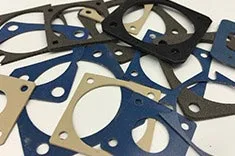EMI Shielding Products
- Custom Gasket Fabrication
- Connector Gaskets
- Bonded O Ring
- Custom Gaskets
- Conduct-O-Knit Knitted Wire Mesh
- Conduct-O-Seal Combo Gasket
- Conduct-O-Elastomer
- Conduct-O-Seal Oriented Wire in Silicone Gasket Material
- Conduct-O-Mesh Tape
- Conduct-O-Foam
- Conduct-O-Bond
- Optical Filters For Electronic Displays
- Shielded Vent Panels
- ESC Board Level Shielding
- 300 Series
Accurately Evaluating EMI Gasket Effectiveness: What Every Designer Needs to Know
 Electromagnetic interference (EMI) gaskets are critical in protecting electronic systems from unwanted interference that could disrupt functionality or lead to failure. However, not all gaskets deliver the same level of shielding effectiveness (SE), and for design engineers, understanding how to measure and apply SE data accurately is critical to high-performance outcomes. Reliable methods for evaluating EMI gasket SE ensure that systems meet functional and safety standards without unnecessary costs or time-consuming tests.
Electromagnetic interference (EMI) gaskets are critical in protecting electronic systems from unwanted interference that could disrupt functionality or lead to failure. However, not all gaskets deliver the same level of shielding effectiveness (SE), and for design engineers, understanding how to measure and apply SE data accurately is critical to high-performance outcomes. Reliable methods for evaluating EMI gasket SE ensure that systems meet functional and safety standards without unnecessary costs or time-consuming tests.
In design engineering, accurate methods for measuring shielding effectiveness in EMI gaskets enable performance optimization and application-specific precision, directly impacting reliability and efficiency.
Why Shielding Effectiveness (SE) Matters for EMI Gaskets
Electromagnetic interference can severely impact the functionality of sensitive electronic systems. EMI gaskets provide the conductive barriers necessary to shield these systems, and their SE directly relates to how well they block electromagnetic energy. For design engineers, the SE of EMI gaskets isn't a generalized attribute but a measurable, application-specific factor that impacts the reliability and safety of designs in real-world use cases.
Empowering Designers with Consistent SE Data: Traditional Challenges in Measuring Shielding Effectiveness
Historically, measuring the SE of EMI gaskets has involved standardized tests in controlled environments, such as shielded rooms or reverberation chambers. Standards like MIL-DTL-83528 and IEEE Std. 299 outline methods to determine SE; however, these methods have limitations. Full-scale testing setups are often costly, time-consuming, and difficult to replicate outside specialized labs. Moreover, they don't always reflect the gasket's performance within specific installation configurations, such as the unique slots or mounting geometries often found in real-world applications.
These challenges leave engineers in a difficult position—testing might produce standardized SE values, but without application-specific context, the data could fall short of real-world performance needs. High costs and extended lead times can add significant friction to the design and validation process for teams on tight schedules.
A New Approach: Combining Standardized Data with In-Situ Measurements
A more tailored approach has emerged to address these limitations. By combining the standardized SE data—typically found in gasket datasheets—with specific application measurements, such as the distance between the gasket and the source of interference, engineers can achieve accurate SE evaluations without relying on extensive test setups. This approach considers critical factors like slot geometry, mounting details, and the specific configuration of the gasket, enabling a more practical and precise SE measurement directly within the design environment.
For example, measuring SE in situ allows designers to apply real-world conditions to standardized data. This results in a more reliable and accurate representation of the gasket's performance under specific operational stresses, such as high-frequency interference or extreme temperature variations. The technique also covers a broad frequency range, from 800 MHz to 18 GHz, accommodating the varied requirements of high-frequency systems. By integrating in-situ measurements with standardized SE data, engineers can reduce project costs and lead times, optimizing SE analysis without compromising accuracy.
Practical Considerations for Designers Selecting EMI Gaskets
Given the stakes, selecting the right EMI gasket involves understanding each project's specific application needs and technical constraints. Here are key considerations:
- Application-Specific Requirements: Different applications may have unique needs, such as specific frequency ranges, environmental durability, or compatibility with certain mounting configurations. By selecting gaskets that meet these requirements, designers can enhance both SE and overall system performance.
- Installation Geometries and Slot Configurations: The shape and size of the slots or apertures where gaskets are installed significantly impact SE. Ensure that the gasket's SE rating, validated through in-situ measurements, aligns with these geometries for optimal performance.
This method of SE assessment provides engineers with reliable data tailored to their project's unique needs, offering a sense of security and eliminating costly surprises, smoothing the design-to-production process.
Optimizing EMI Gasket Designs with Accurate SE Measurement
In design engineering, accurate SE measurement isn't just a formality; it's a practical necessity for creating reliable, interference-free systems. By incorporating real-world measurements into standardized SE data, engineers can precisely understand how EMI gaskets perform within their unique designs, leading to higher reliability and efficiency.
Learn more about East Coast Shielding's EMI gasket solutions, which are tailored for performance and precision in any design environment. Our team is here to help you maximize your EMI shielding needs, whether you're designing for aerospace, telecommunications, or advanced automotive systems.



